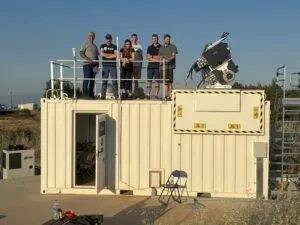The link is with NASA’s Deep Space Optical Communications (DSOC) experiment, which is onboard its Psyche mission. This is currently at a distance of 1.8 astronomical units, which is around 265 million km. The Psyche mission involves a spacecraft studying a distant metal-rich asteroid.
“The first successful demonstration of deep-space optical communication with a European ground segment marks truly a leap step towards bringing terrestrial internet like high-speed connectivity to our deep-space spacecraft,” said Rolf Densing, ESA’s Director of Operations.
“This joint achievement together with our colleagues and partners in industry and academia, ESA’s Directorate of Technology and NASA/JPL underlines the importance of international cooperation.”
Kryoneri
ESA transformed two observatories in Greece into high-precision optical ground stations for this purpose.
One is Kryoneri Observatory, located near Athens. Basically, a powerful laser beacon is precisely directed towards the Psyche spacecraft so it can lock onto it. Though it carries no data outwards, Psyche can then send a return signal back to Earth. The return signal arrives at the Helmos Observatory, situated 37 km away on a neighbouring mountain.
The Ground Laser Transmitter integrates five lasers with ultra-precise steering controllers. It also involves a special 20-foot-long container with a lifting platform that is used after sunset.
Summer links
The optical connection is actually the first of four links due to occur this summer, says ESA.
The agency highlighted its close work with NASA in the realm of optical communications. This is something, it said, it has previously only achieved with radiofrequency systems.
Previously, in April, the research team ran a rehearsal campaign by beaming a single low-power signal to ESA’s Alphasat satellite. This is located in geostationary orbit, at 36 000 km altitude.
The agency describes the satellite as a prime test bed for optical communications technologies. This is thanks to a bespoke optical communication terminal provided by Germany’s DLR.
Image: The Ground Laser Transmitter at the Kryoneri Observatory
See also: European Space Agency looks ahead with ESA Strategy 2040

